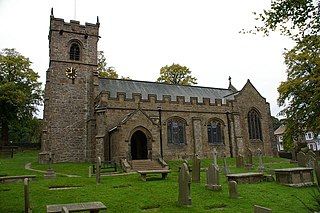
Turweston is a village and civil parish in north-west Buckinghamshire, England. The village is beside the River Great Ouse, which bounds the parish to the north, west and south. Turweston is the most northwesterly parish in Buckinghamshire: the Ouse here forms the county boundary with Northamptonshire to the north and west and Oxfordshire to the south. Across the river, the Northamptonshire market town of Brackley is just west of Turweston, with the town centre about 1 mile (1.6 km) west of the village. The parish has an area of 1,295 acres (524 ha) and had a population of 211 at the 2011 Census.

Wadenhoe is a village and civil parish in North Northamptonshire. The population of the civil parish at the 2011 Census was 244. It is on the River Nene, approximately 4 miles from Thrapston and 10 miles from Corby. The Nene Way long-distance footpath passes through the village.

All Saints' Church is an ecumenical church located in Loughton, Milton Keynes, England.

Hanbury is a rural village and civil parish 3.3 miles (5.3 km) west-north-west of Burton-on-Trent in Staffordshire, England. It is bounded to the north by the River Dove.

St Bartholomew's Church is in the town of Colne in Lancashire, England. It is an active Anglican parish church in the Diocese of Blackburn. There has been a church on the site since no later than the 12th century although the present building mostly dates from the 16th century. It is recorded in the National Heritage List for England as a designated Grade I listed building.

Leighton Bromswold is a small village and civil parish in Cambridgeshire, England. Leighton lies approximately 10 miles (16 km) west of Huntingdon. Leighton is situated within Huntingdonshire which is a non-metropolitan district of Cambridgeshire as well as being a historic county of England. The civil parish of which it is part is called Leighton and in 2001 had a population of 224, falling to 210 at the 2011 Census. The parish covers an area of 3,128 acres (1,266 ha).

The Church of St Michael and All Angels is a parish church located on Riverside in Felton, Northumberland, England. Built circa 1200, its many alterations and additions have caused it to be almost encased within another church. Some unusual features are that the nave and an aisle appear roofless, as well as a window with geometrical tracery that features an eight-petalled flower patterned central circle cut from a single stone. Dedicated to Saint Michael, it is a Grade I listed building.

All Saints' Church is a 13th-century pilgrims' Grade I listed church in Boughton Aluph near Ashford, Kent. It is part of the Church of England.

St Peter's and St Paul's Church is a parish church in Headcorn, Kent dedicated to saints Peter and Paul. It was begun in the 13th century. The church is a Grade I listed building.

All Saints Church is a parish church in Hollingbourne, Kent. It was begun in the 14th century and is a Grade I listed building. The church contains numerous monuments to the local Culpeper family.

All Saints is a parish church in Ulcombe, Kent. It was begun in the 12th century and is a Grade I listed building.

St Peter's and St Paul's Church is a parish church in Yalding, Kent, dedicated to saints Peter and Paul. It was begun in the 13th century and is a Grade I listed building.

The church of St Mary the Virgin is an Anglican parish church in the village of Hanbury, Worcestershire. Its earliest parts date from about 1210 and it is a Grade I listed building. The church was the family church for the Vernon family of nearby Hanbury Hall.

St Nicholas' Church is a Grade I listed parish church in the village of Berden, Essex, England.

St Mary and St Peter's Church is a Grade I listed Church of England parish church dedicated to Saint Mary and Saint Peter in Harlaxton, Lincolnshire, England. The church is 2 miles (3 km) south-east from Grantham, and at the eastern edge of the Vale of Belvoir in South Kesteven.

St James the Great Church is a Grade I listed Church of England parish church dedicated to James, son of Zebedee in Aslackby, Lincolnshire, England. The church is 7 miles (11 km) north from Bourne, and in the Aslackby and Laughton parish on the eastern edge the South Kesteven Lincolnshire Vales.

St Andrew and St Mary's Church is a Grade I listed Church of England parish church dedicated to Saint Andrew and Saint Mary, in the parish of Easton and the village of Stoke Rochford, Lincolnshire, England. The church is 5 miles (8 km) south from Grantham, and at the western side of the Lincolnshire Vales in South Kesteven.

St Leonard's Church is in the village of Downham, Lancashire, England. It is an active Anglican parish church in the diocese of Blackburn. The tower dates from the 15th century, and the rest of the church was rebuilt in 1909–10. The church is recorded in the National Heritage List for England as a designated Grade II* listed building.

St Botolph's Church is an Anglican church in Quarrington in Lincolnshire, England. The area has been settled since at least the Anglo-Saxon period, and a church existed at Quarrington by the time the Domesday Book was compiled in 1086, when it formed part of Ramsey Abbey's fee. It was granted to Haverholme Priory in 1165, and the Abbey claimed the right to present the rector in the 13th century.

The Church of St Thomas à Becket, Ramsey is the Church of England parish church of Ramsey, Cambridgeshire. The parish is part of a benefice that includes also the parish of Upwood with Great and Little Raveley.






















